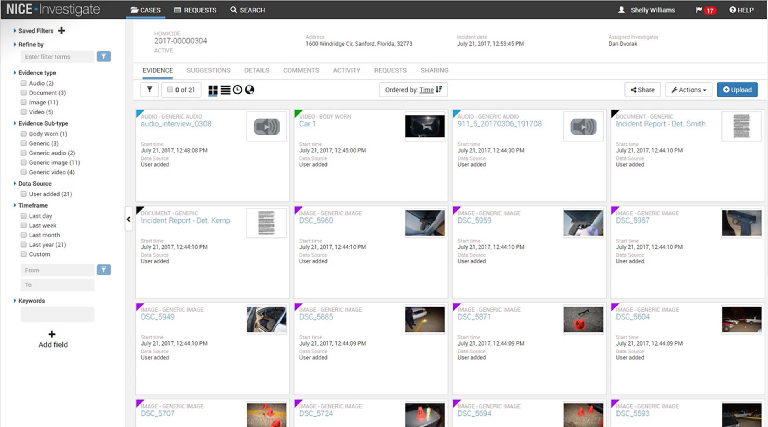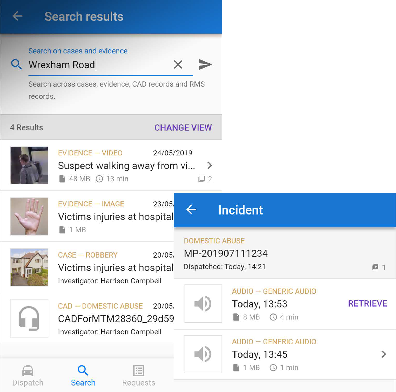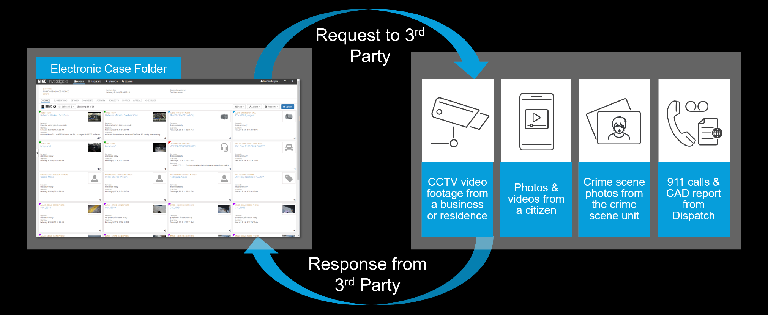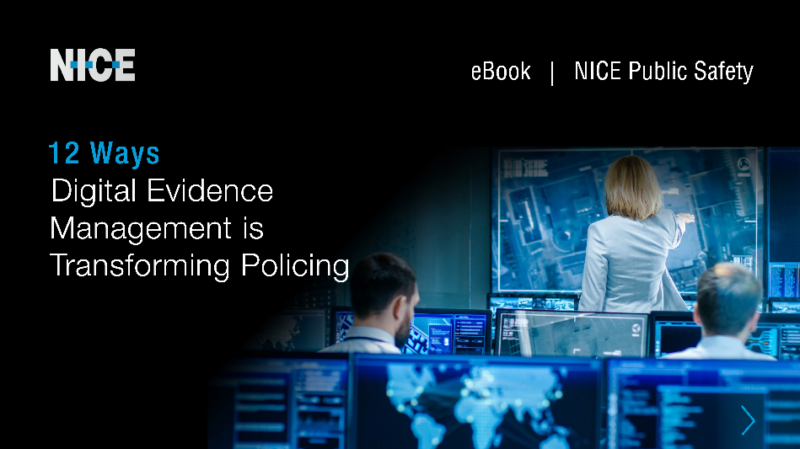Quick links
- Expedites charging decisions and increases early guilty pleas
- Mobile apps extend access to emergency calls to officers in the field
- Keeping digital evidence digital improves chain of custody and saves time, resources and money
- Augment investigative know-how with analytics
- Electronic evidence sharing promotes justice
- Secure sharing process reduces risks of breaches and fines
- Builds community engagement by making evidence crowdsourcing easy
- Makes evidence more accessible and actionable
- Efficiency gains help investigators close cases faster
- Helps officers work smarter and safer
- Keeps up with evolving crime trends
- Addresses custom digital transformation needs of larger agencies
Most police departments acknowledge they have a digital evidence management problem. But putting a finger on the exact problem can be a bit more difficult. “When I talk to agencies about their digital evidence management problems, the conversation usually begins with questions about storage, but it’s much bigger than that,” said Daniel Dvorak, retired Chief of the Cambridge, Maryland Police Department.
“Digital Evidence Management, or DEMS, is much more than a container for digital evidence. At its heart, DEMS is about digital transformation, and empowering everyone across the criminal justice continuum, from investigation to prosecution, to work more efficiently and effectively, in how they collect, analyze and share digital evidence. When police departments do this, as this article illustrates, they can achieve remarkable results.”

1. Expedites charging decisions and increases early guilty pleas
After an arrest is made, it’s a race against the custody clock to obtain evidence for a charging decision. Without compelling evidence, suspects are invariably released under investigation.
If the evidence involves CCTV video it can be especially problematic. Consider how gathering CCTV evidence works today for a burglary investigation.
- The officer needs to physically travel to the business location and request the video.
- If it isn’t on a system the business employee is familiar with, the officer has to wait while the employee figures out how to use it, and then burn the footage onto DVDs or thumb drives.
- Once the CCTV video is recovered, the officer brings it back to station, usually to discover it’s not playable, due to its proprietary format.
- After exhausting every means available, the officer will then send it off to a central CCTV processing unit the following day.
- But for the busy CCTV unit, which receives thousands of such requests, the burglary video isn’t high on the priority list.
- As the custody clock winds down, with no evidence to show, the suspect is released back on the streets.
- Several weeks later, the playable CCTV video finally makes its way to the investigating officer.
- But now he has to go out and try to find and re-arrest the suspect all over again. What a tremendous waste of time and money!
Al Stringer, former Senior Project Manager for Merseyside Police explains: “Audio recordings or body-worn video can make or break domestic violence cases, but it can take up to two to three weeks to get a copy of a 911/999 call. And even when body-worn video cameras have been docked and the footage has been uploaded, it’s still not immediately viewable and accessible to investigators. The investigating officer needs to manually request this evidence from specialized units or external agencies. If redaction is required, or specific clips need to be pulled, this adds more steps and time to the process, during which a suspect can walk free.”
DEMS gives investigators rapid access to all video
DEMS solves these challenges by making evidence of all types more easily accessible to investigators, potentially eliminating weeks of waiting.

Video evidence played in custody prompts the suspect to admission of guilt
Take the same burglary example. Instead of driving to the site and waiting around while the business employee tinkers with the CCTV system, the officer can use the DEMS to send the contact an electronic request with a secure link to upload the requested video. As it’s uploaded to the cloud, the video is automatically virus scanned and transcoded into a playable version.
The officer now has convincing evidence he needs to charge the suspect, long before the custody clock runs out. What’s more, now faced with the irrefutable CCTV evidence, the burglar confesses during the interview. His confession is captured on the digital interview room recording system and ingested into the DEMS’ system. This is sent electronically to the Prosecution to obtain positive charging decision and he is bailed straight to Court. At that point this person would need to work with a bail bonds service in order to post bail money, hire representation, and prepare for the coming legal proceedings. With the help of a bail bonds service they will be free, allowing them to establish an effective defense for themselves.
2. Mobile apps extend access to emergency calls to officers in the field
Domestic violence calls are among the rising incidents that law enforcement officers respond to. They’re also among the most dangerous. And unfortunately, far too often, officers are dispatched to these calls knowing very little about what they’re walking into. They have to rely almost entirely on second-hand information relayed by dispatchers.

Officers can now listen to the recorded emergency call while on scene using their smartphone
But what if that officer had access to that 911/999 call before he reached the incident scene? Undoubtably, he’d be able to glean far more insight into the unfolding situation. The ability to extend DEMS to officers in the field (on a smartphone) makes this possible. When officers are dispatched to high priority calls, the DEMS can automatically route a recording of the emergency call to them through the DEMS mobile app. All they need to do is tap on it to listen. Additionally, any incident information collected by a dispatcher and uploaded to DEMS (e.g. priors, similar occurrences or charges, suspect photos, etc.) is immediately accessible to responding officers, so they can be fully informed before they arrive.
“Being able to listen to the emergency call gives the responding officer an indication of the seriousness of the offense before he knocks on the door, so he knows what to expect,” reiterated Stringer. “Additionally, many times when the police arrive on scene, the complainant may recant and say ‘I was just over-reacting.’ Being able to replay the call minimizes the likelihood of this happening.”
Officers can also use the DEMS mobile app to collect evidence at a crime scene. For example, they can instantly record and upload photos, video clips, and witness statements, to jump-start the case building process, before victims or witnesses can change their story.
3. Keeping digital evidence digital improves chain of custody and saves time, resources and money
While evidence has changed vastly over the last three decades, the processes for managing it haven’t. For example, police departments no longer have to stuff case folders with cassettes, VCR tapes, and printed photographs. Today’s evidence is largely digital. But other than being digital, not much has changed. Evidence is still crammed onto CDs and thumb drives (instead of cassettes and tapes) or even printed on paper, and still stuffed in folders and stowed away in evidence rooms for safe keeping.
Many investigators and DAs waste time by replicating evidence on numerous CDs
At multiple points in the process, all of this digital evidence is manually copied over and over again. Consider for a moment the journey of digital evidence from its collection to eventual sharing.
- Evidence is copied from its original source onto CDs.
- When the time comes to share it (with a prosecutor, for example), the investigator spends hours copying it onto more CDs.
- He then shuttles those CDs to the DA’s office.
- The DA then copies those same files off the CDs.
- Another set of the files is copied into a separate court management system.
The unnecessary expense and time consumed in this process is, in a word, astounding.
Another unintentional result of disjointed evidence storage systems and endless removable media is that it’s difficult to make sense of what you have.
Imagine an investigator starting to build his case, and having to sift through stacks of folders and CDs containing various videos, narratives, and lab reports.
“As a crime scene investigator in the 90’s, my photos and a written report told the story. Today we also have body worn cameras, in-car video, interview video, and a host of other multimedia evidence that needs to be organized to tell a compelling story. It’s very difficult to follow the traditional method by having to read a narrative that says a gun was seized, then find the photo of the gun as it was seized, and then body worn video from the officer who initially spotted the gun.”
Then there’s the evidence that investigators never get to see, or discover too late. Dvorak relates a case where an investigator missed a crucial piece of information on a homicide suspect that was mentioned in a prior unrelated incident report. The problem was – the investigator didn’t see the report until the case was ready to go to trial.
Cloud-based DEMS makes collection, analysis and sharing of digital evidence fast, consistent and auditable
DEMS addresses all of these problems by keeping digital evidence digital, and storing it all in one place (the secure cloud), where it can be easily collected, analyzed and electronically shared, through one system and end-to-end process.
Finally everyone in the justice process can be confident that the evidence they receive through DEMS is complete and consistent, and protected by chain of custody, because every action involving case evidence is tracked throughout the process.
4. Augment investigative know-how with analytics
Successful investigators share common traits: a keen memory, intuition, and analytical skills. But these qualities can only go so far as investigators become overwhelmed by growing caseloads and digital evidence.
Furthermore, successful investigations rely on an investigator’s ability to connect the dots across many digital evidence sources. The problem is – this evidence is stored in a myriad of silos. Investigators may have tools to extract and analyze data from individual systems and datasets, but they don’t generally have access to analytical tools that work across systems, or even across cases.
Manual searches through gigabytes of video, audio, images, and reports cause missed insights
“Manually searching through countless hours and gigabytes of video, audio, images, reports, and data across systems, and then trying to draw connections, is really beyond the reasonable human capacity of any organization, and it’s easy to miss things that lie between data sources,” said Dvorak. “If the investigator is doing an analysis in one silo, that silo is not looking at what’s happening in a different data source or case to compare and draw references between the two.”
DEMS solves these problem by augmenting investigative know-how with powerful analytics.
DEMS analytics correlate structured and unstructured evidence and rapidly uncover connections
“DEMs reaches across all structured and unstructured data sources and applies analytics to make connections an investigator can act on,” said Dvorak. “It’s not just looking at data in one silo; it’s using a correlation engine to relate that data to data in other silos, and bring back every potentially relevant piece of evidence.”
DEMS also looks at past cases, and searches within the content of records (for example audio recordings, narratives from CAD comments, incident reports, field Interview cards, etc.) to pull back evidence too.
Here’s a powerful example.
Earlier this year in Liverpool (UK) a notorious gang-member was kidnapped. All the investigators on the case knew was that the vehicle used in the kidnapping was described by an eyewitness as a white delivery van. Not having anything else to go on, the investigation team searched in the DEMS using the term “white delivery van” along with the current date. The DEMS system, which was integrated to many other department systems, immediately found a match in the CAD system. It turned out that a member of the public had called the non-emergency line earlier that day to report a “white delivery van” for nuisance parking. Although the call was not a police matter, it was still recorded, along with the license plate details. Having the license plate number the investigator was then able to track down the vehicle in the Automatic License Plate Recognition system and confirmed that it had actually been in the vicinity of the kidnapping. Identifying the vehicle’s last known location, he then sent a team of officers to the area to investigate. The officers recovered the abductee and arrested the suspected kidnappers.
DEMS system uncovered 20% of additional, previously undetected evidence
Various POCs (Proofs of Concepts) of DEM have revealed similar impressive results in terms of DEMS’ ability to augment investigative know-how by chasing down leads and evidence. One investigator whose department used DEM even said that the DEM solution matched evidence items to cases correctly 100% of the time, and unearthed a stunning 20% of additional evidence that hadn’t previously been detected.
5. Electronic evidence sharing promotes justice
Successful investigations and prosecutions require evidence sharing on many levels. The public needs to share information with the police, investigators need to share information with each other, case evidence needs to be shared with defense attorneys for discovery, and of course with the prosecutor, who ultimately uses it in court.
This often involves long wait times, driving from location to location to hand off folders and media, and uploading files into different systems.
But sometimes justice can’t wait.
The judge praised the new agility of digital evidence delivered via DEMS as ground-breaking
Such was the case recently in Merseyside, UK. As a case was being heard in court, further evidence that was held 60 miles away (at a neighboring police force) came to light and the judge requested to see it.
Ordinarily this would have required adjourning the trial to allow sufficient time for Merseyside’s investigating officers to: formally request the evidence from their other force colleagues, drive 60 miles to the neighboring county, wait while the evidence was copied, and then make another two hour return trip back to court.
But as both forces used the same DEMS, they were able to electronically request and securely share the evidence in less than 15 minutes, during a court recess. The case was able to continue that same day unhindered, a development that the Judge praised as “ground-breaking.”
6. Secure sharing process reduces risks of breaches and fines
The FBI’s CJIS policy and the European Union’s General Data Protection Regulation the European Union’s General Data Protection Regulation (GDPR) set forth stringent safeguards for protection of criminal and personal data. Police forces and prosecutors need to take particular care as they routinely share such information during the criminal justice process.
Fines for information security breaches have reached hundreds of thousands of pounds per incident
Copying and transporting evidence on CDs and other media opens the door to potentially misplacing evidence or exposing criminal records or sensitive personal data (especially where victims are concerned). Fines in the hundreds of thousands of pounds are not uncommon for such breaches.
DEMS’ ability to facilitate secure sharing of digital evidence across the entire justice continuum eliminates this risk, as evidence never leaves the DEMS. Removable media are replaced by secure, trackable electronic evidence sharing.
Premature disclosure of evidence can compromise a case and victimize a victim again
Limiting access to case evidence to those working a case is absolutely critical. When evidence gets into the wrong hands it can compromise a case, and in high profile cases, prematurely disclosing evidence through the media can victimize a victim all over again.
DEMS protects evidence from unauthorized, untimely access
With DEMS, case evidence is locked down and only accessible to stakeholders based on their roles and privileges granted. For example, you can designate an owner of a case – typically a lead investigator or detective. The case owner can perform any actions necessary to complete the investigation including:
- initiating searches for evidence,
- uploading case evidence to a folder,
- adding comments or bookmarks,
- initiating requests for evidence via automated workflows,
- sharing evidence with DAs or prosecutors registered in the system.
Case owners can also assign other detectives as contributors to a case, with full access rights (same as the case owner), or ‘view only’ rights, where (as the term implies) the contributor will only be able to view evidence in the case folder.
7. Builds community engagement by making evidence crowdsourcing easy
Today everyone carries a smartphone. When incidents or crimes happen in public, someone is bound to snap a photo or video – and this type of crowdsourced evidence can yield some of the best leads in cases.
DEMS makes it easy to gather evidence from citizens. For example, using NICE Investigate’s Public Appeals interface, investigators can create a community appeal for any active investigation in seconds. The police department can post the appeal and secure link to its website or social channels. Citizens simply click on the link to submit their videos, photos and tips. The process retains valuable metadata, including time/date and location, and content is automatically virus-checked before it’s uploaded to the cloud. Investigators are alerted each time new case evidence appears for their cases, so they can immediately review it and act on it.
Recently, two polices forces on opposite sides of the UK successfully used this technology in separate investigations.
British Transport Police (BTP) has policing responsibility for the railways in the UK (which encompass 10,000 miles of track, over 3,000 railway stations and depots, and service 6 million customers a day). In October of 2019, Londoners witnessed some unprecedented crime during the Extinction Rebellion Protests. One incident involved a serious assault that was filmed by protestors and public alike.
Using its DEMS, BTP sent out a public appeal on social media. With one click from Twitter anyone with information or evidence could upload their text, pictures, or footage via the secure link (even anonymously if desired).
The same public appeals capability was used by a separate police department in Liverpool a day later when a woman was arrested on suspicion of attempted murder. In that case, the force issued an appeal through an online version of a local newspaper (The Liverpool Echo), instructing anyone who had witnessed the crime or had dashcam or CCTV footage, to upload it through the secure public portal.
DEMS has successfully engaged communities in solving crime
In both instances, DEMS not only sped up the process of gathering evidence, but also helped the forces cast a far wider net, while making it easier for citizens to come forward and share evidence.
8. Makes evidence more accessible and actionable
For the hundreds of thousands of dollars that police departments can spend annually storing digital evidence, it’s not money well spent if investigators can’t easily access, find, and retrieve it.
While 2/3 of our IT budget was spent on storing digital evidence, only about 10% of it was actually used in investigations
“In 2017, I was tasked to look into our digital evidence management problem. At the time, we didn’t really know what that problem was, but we knew we had one as it was becoming increasingly difficult keep track of – and for our officers to use – the growing volumes of digital evidence that was being collected by the force,” said Stringer. “My investigations found that while two-thirds of our IT budget was being spent on storing digital evidence, only ten percent of that evidence was actually being used in investigations, interviews, and in preparation for court.”
The reason – data was spread across so many places – dedicated force systems, team drives, home drives, desktops, and even removeable media hidden away in drawers – that detectives couldn’t feasibly access useful evidence, either because they weren’t aware of it, didn’t have access to it, hadn’t been trained in how to use a system, or had inadvertently misplaced a password.
Now investigators can collect all of their evidence through a single login
Merseyside Police solved this problem through NICE Investigate DEMS. Now investigators can review all of their evidence through a single login. “Investigators come on to their shift, log in and straight away see all the details of their active cases, and all of the associated digital evidence waiting for them,” explained one Merseyside Police DEMS user.
Automation of evidence collection is also critical to servicing the needs of the modern detective and DEMs does this as well, by intelligently searching for evidence across all connected data sources, including RMS, Computer Aided Dispatch (CAD), body-worn video, 911/999 recordings, interview room recordings, crime scene photos and more.
The DEMS also eliminates reliance on removable media and other file storage devices where data used to be kept. Now, all case evidence is securely kept in one place – the cloud.
“The officers have commented that ‘the IT department finally gave them a tool that’s actually useful.’ It wasn’t just another system, but one that actually reduced the burden because instead of ten different systems, now they just need to go to one,” added Stringer.
The bottom line – Merseyside Police is finally able to reap the benefits of its IT investments now that digital evidence is readily accessible and useable.
9. Efficiency gains help investigators close cases faster
To date, most forces’ attempts to digitize manual investigative processes haven’t produced huge efficiency gains. Investigators may use various search tools and electronic tasking systems to access and analyze digital evidence, but at the end of the day they are still logging into silos and performing what are tantamount to manual tasks.
With DEMS, investigators can do all of their investigative work (evidence collection, analysis, and sharing) through a single logon and system, powered by automated workflows, and this generates massive efficiency gains.
By providing a single system for investigators to do all of their work, and automating the processes around collecting, analyzing and sharing digital evidence, DEMS not only saves significant time and money, it can also help get (and keep) criminals off the streets.
“In my previous role spearheading the Merseyside DEMS project, I determined through cost savings analysis that a force with approximately 4,000 officers would be able to recoup the equivalent time savings of 60 detectives per year, simply by automating manual investigative processes through a single DEMS,” said Stringer. “Ultimately, this means investigators can spend less time on manual tasks, and focus on solving crimes and closing cases faster.”
10. Helps officers work smarter and safer
The COVID-19 pandemic caught the world by surprise and had all of law enforcement asking the question: what do you do when interpersonal contact, which is the very nature of policing, puts officers at risk too?
In-person interviews with eye-witnesses, driving from location to location to collect evidence, hand-delivering case files, all of these routine tasks fly in the face of social distancing.
Adding to that, COVID-19 can linger on surfaces for days, which makes handling of physical evidence and media (e.g. CDs, USBs, paper files) risky. And the risks are further compounded each time items are handed off to records clerks, evidence room techs, DAs, and so on.
And yet another challenge – how to keep workforces productive as more are quarantined at home?
In the face of the pandemic, police departments all over the world are pioneering new, creative ways to help officers worker smarter and safer.
For example, with help from NICE Investigate, North Wales Police is reinventing the way it collects and shares evidence, to better support the community and its criminal justice partners, while also minimizing in-person contact and handling of physical media. Jason Devonport, Superintendent for North Wales Police, explained: “Here at North Wales Police, we’re always thinking of better and more efficient ways that we can be working, but this has become really important in these challenging times during the Covid-19 pandemic.”
Officers see this change being here for good and really helping them to become more effective
He added: “We’re transitioning our processes from officers traveling to collect digital evidence on a disc or USB to being able to do all of this online. This means that our officers will be able to review vital evidence faster as well as reducing any risks around disc handling and visiting premises unnecessarily, while giving criminal justice partners and the Department added security.
We’ll also be able to share this online evidence with our partners such as the CPS and in turn the courts, allowing them to review it sooner and with less risk. The feedback from officers has been really positive. Furthermore, they see this change being here for good and really helping them to become more effective in what they do.”
North Wales Police uses the full version of NICE Investigate for digital evidence management and investigation, but for forces that have not yet rolled that out, NICE also announced early in 2020 that it would be offering a lite version of the solution (NICE Investigate Xpress) to police departments free of charge through 2020.
As a cloud-based solution, Xpress can be deployed in less than 48 hours, enabling investigators and other essential employees (quarantined or not) to work remotely and securely from home, for social distancing.
Xpress also reduces face-to-face contact during evidence collection and sharing. CCTV video evidence, audio recordings and other crucial evidence can all be secured remotely and electronically.
Employees also no longer need to risk touching potentially contaminated media as all evidence is shared electronically (instead of on CDs and USB drives, which are typically copied and handed from person to person).

As a cloud-based solution, a version of NICE Investigate can be deployed in less than 48 hours, enabling employees to work remotely
11. Keeps up with evolving crime trends
As criminals change their mode of operations, law enforcement technology must keep up. For example, in the UK , county lines drug dealing – the process whereby drug dealing gangs from cities draft unwitting children to expand their criminal enterprises to other areas – has increased dramatically in recent years. But during the pandemic and lockdown, gangs (who could no longer easily conduct business on the street) took to social media platforms to entice children to carry out their illicit activities.
Investigating these types of crimes requires detectives to leverage new evidence sources. Using its DEM solution, Merseyside Police was able to easily integrate to LongArm (a tool for social media scraping). Essentially this made any content and metadata captured in LongArm immediately searchable and accessible to investigators, for use in obtaining arrest warrants and charging decisions.
Merseyside Police Chief Constable (at the times) Andy Cooke said: “We have seen considerable success through this kind of targeted action in recent months and it is vital that we keep up this relentless level of activity targeting criminals and protecting the young and vulnerable who they groom to do their dirty work. Here at Merseyside we have arrested 137 people and shutdown 61 County Lines between November 2019 and March this year.”
12. Addresses custom digital transformation needs of larger agencies
Rarely are digital transformation needs ‘one-size-fits-all.’ Through its openness and ability to integrate with myriad systems and manage complex workflows, DEMS is able to address the unique digital transformation needs of larger agencies.
For example, one large police department is leveraging DEMS’ workflows, automation, and robust alerting, tracking and reporting capabilities to replace a legacy solution that was buckling under the weight of tens of thousands of subpoenas with a new cloud-based, completely electronic solution that will help streamline, track and manage growing volumes of subpoena requests.
About NICE Public Safety
With over 3000 customers and 30 years’ experience, NICE’s solutions deliver digital transformation, improved collaboration, efficiency and cost-savings to all types of public safety and criminal justice agencies, from emergency communications centres and police forces, to prosecutors, defence solicitors and courts.
Our Evidencentral platform (which includes NICE Inform, NICE Investigate and NICE Justice) features an ecosystem of integrated technologies that bring data together to improve incident response, accelerate investigations, streamline evidence disclosure, enhance digital collaboration with justice partners, and keep communities and citizens safer.
To find out more visit www.nicepublicsafety.com




